“Harriers” in battle: Falklands conflict 1982 (part of 7)
On this day, the Argentinean command decided to make maximum efforts in order to turn the tide of the fighting. The point was, of course, not only and not so much in the desire to celebrate Independence Day, but that the British had been unloading for four days, and soon the main forces of the landing along with the supplies would be on the shore, and then trying to inflict unacceptable damage on the British more difficult. But besides this, the Argentines finally groped for the location of the British aircraft carriers and were preparing to strike at them.
The first blow to the transports was to be inflicted by the 4 Skyhawk, which rose into the air around 08.00 in the morning. Two of them (traditionally) for technical reasons returned to the airfield, the remaining two instrument-wise discovered the British ship and launched an attack on it, but ... this turned out to be the hospital ship Uganda. To the credit of the Argentine pilots, in the few seconds remaining with them from the moment of visual detection of the target, they were able to figure out what their target is and refrain from striking. On departure, one Skyhock was shot down by the Sea Dart destroyer Coventry - the British opened an account.
Four Daggers appeared over the islands two hours after the events described above - Falkland shrouded in thick fog, so the Argentines could not find the ships of the British, but the British did not risk lifting their aircraft into the air. The Daggers returned, and after another hour and a half, the four Skyhocks arrived - they were able to find the enemy by attacking the amphibious ship dock, the Fireless, and the frigate The Evenger, which was covering it. The British shot down the Skyhawk, which aimed at the Fairless, but it’s not clear how: either the calculation of the C Cat missile system from the Yarmouth frigate (according to British data), or the Rapier missile system from the ground worked well (in Argentine). The three remaining Skyhawks attacked the Evenger, luckily for the British, unsuccessfully. But the ubiquitous “Coventry” re-used its “Sea Dart” as intended, knocking down the Skyhawk of the group commander when he gained altitude after the attack. Another Skyhawk was badly damaged, but still the surviving pair of aircraft was able to return to the continent.
The Coventry / Broadsword pair annoyed the Argentines very much the day before - their aviation suffered a lot from the Sea Harriers, which were directed by Coventry, and now the long-range Sea Dart has come into play. Therefore, it is not surprising that they were specifically designated as the target for the subsequent strike: perhaps the Argentines hoped that by destroying the British RLD patrol, it would become easier for their strike groups to attack transports? Be that as it may, Coventry eavesdropped on the conversations of Argentine pilots (there was a man who spoke Spanish among the crew) and knew about the impending strike. Even the composition of the strike group allocated for the destruction of Coventry was not a secret for the British - 6 Skyhawks. But from the six that rose into the air, two Skyhawks returned for technical reasons, so that only four aircraft struck.
However, this time the Argentines resorted to an interesting innovation - realizing that the tactics “jumped out of the mountains and tried to drown someone” did not work too well, they decided to use external target designation for targeting the Skyhawks group attacking Coventry. The Argentines used as a reconnaissance and control aircraft ... a mobilized passenger airliner, the Liar Jet 35A-L. Given the fact that the aircraft of this type did not have any military equipment, having only "native" civilian avionics equipment, their use did not look too sophisticated form of suicide crews. But in speed, these airliners were superior to the British "Harriers", so if necessary, Liar Jets could avoid interception. Of course, they were threatened with Sea Darts, but there was a hope of finding the British first and not putting themselves in jeopardy of the only long-range British air defense system. Of course, the use of a civilian airliner as an Airborne Aeronautical Plane could only be done in a desperate situation, but this was what the Argentines had. And, as it is not surprising, an airliner as a control point for aviation turned out to be preferable to a modern destroyer, stuffed with powerful radars and other combat electronics.
All four Skyhawks pointedly walked at a medium height, so the British found them about 100 miles from San Carlos. Naturally, Sea Harriers received target designation and rushed to intercept, but as soon as Liar Jet 35A-L considered that the British were close enough, Skyhawks abruptly went down. Thus, the strike group disappeared from the screens of the radars of British ships, and they could no longer direct the Sea Harriers, and the British pilots had not yet managed to detect the Argentines, and now they had little chance of finding Skyhawks. At the same time, the position of the British ships, although it allowed to successfully perform the functions of aircraft operators, was not optimal from the point of view of its own air defense - they could be approached imperceptibly from the islands. That is what the Argentine pilots did, "Liar Jet 35A-L" gave them the most important thing - the location of the British, and only to lay a suitable route was a matter of technology.
The first couple of Skyhawks were spotted by the British in the Coventry destroyer zone and immediately called off Sea Harriers, fearing “friendly fire”. This turned out to be a mistake: the radar station, which was responsible for targeting the Sea Dart anti-aircraft missiles, once again failed to capture low-flying targets, and the “Sea Wolf” of the frigate “Broadsward”, unexpectedly for its operators, portrayed Buridan's ass. The OMS of the complex captured both targets, but the software could not decide which of them was a priority. Of course, from the point of view of “artificial intelligence”, it could not have been a question of letting this responsible choice be made to despicable people ... As a result, the attack of the first pair of Skyhocks reflected only artillery and several sailors who were shooting at weapons. This did not stop the Argentines.
Of the four bombs, three missed the target, but the fourth still landed in the stern of the Broadsworth. And, of course, did not explode. Nevertheless, the flight deck (helicopter) was badly damaged, a fire started and water began to enter the ship - the bomb broke the board just a meter above the waterline. But the emergency party worked perfectly and the frigate did not lose its combat capability.
"Coventry" turned to go to the rescue of "Broadsward", but then the second deuce of "Skyhawks" appeared, and due to the turnaround of the destroyer, they came from the stern, from the sector where the Sea Dart air defense system could not reach them. And here the commander of "Coventry" made quite understandable, but became a fatal mistake for his ship. In an effort to attack the Argentines with his air defense missile system, he turned around again, not taking into account that as a result of this maneuver, his destroyer closes the line of fire for the anti-aircraft gunners at Broadsworth. But by this time, the ZRK’s calculations had already sorted out on a software error, took Skyhawks to escort and were ready to transmit to the Argentine pilots the exact coordinates of the wintering sites of the crayfish ... The Sea Dart destroyer did launch the missiles, both of them did not hit, after which the complex (and I want to write: “from grief”) failed. The Coventry was hit by three bombs of the leading Skyhawk of First Lieutenant M. Velasco, the second plane refused the mechanism of the bombers and its pilot could not attack the British. But Velasco's “gifts” were enough for the British ship, all three bombs exploded and after just 20 minutes after the Coventry attack sank.
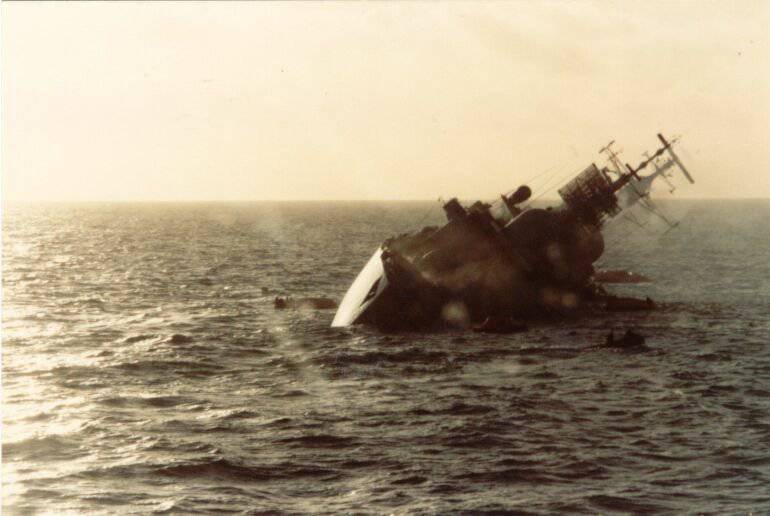
The radar patrol of the British turned out to be broken. Surprisingly, but two British ships with experienced crews and the newest air defense systems, supported by at least two Sea Harriers, were completely defeated by four Skyhawks operated from a passenger liner. All Argentine aircraft returned home.
This fiasco was a heavy blow to Rear Admiral Woodworth. Here is how he describes this episode:
This was, without a doubt, the most difficult moment for me in the whole operation. I returned to my cabin in order to spend some time alone with myself. He opened the notebook and made a few comments.
1. 42 / 22 combination does not work.
2. "Sea Dart" is practically useless against low-flying targets.
3. "Sea Wolfe" is unreliable.
4. Surface ships, in order to survive on the high seas, must have long-range air detection and air cover in a threatened direction.
5. We must conduct more rigorous and comprehensive tests of air defense systems.
6. Strive to act at night or in bad weather.
7. Now they must try to strike at the aircraft carriers!
Premonition did not deceive the British commander. At that moment, when he wrote these lines, a pair of “Super Etandars” flew to him with two of the three remaining air-based RCCs from the Argentines.
Interestingly, the location of the British aircraft carriers, which were approximately 80 miles from Stanley, revealed ground-based radar. Of course, the curvature of the globe did not allow the Argentines to detect a British compound, but they had the opportunity to observe the flights of “Sea Harriers”, taking off from the deck and returning from combat duty. Having determined the place where British aircraft go down when returning and gain altitude during take-off, the Argentines thereby calculated the position of Invincible and Hermes. Guided by these data, the Super Endandar pair went on a raid, and the position of the British aircraft carrier group was determined with quite acceptable accuracy - the deviation of the actual position of the ships from the calculated one was approximately 80 km. Super Etandara discovered English ships led by the aircraft carrier Hermes about 18.30 from a distance of about 40 miles. True, some sources indicate that the C-130 “Hercules” performed targeting to the target, but the author does not have accurate data on this score.
Be that as it may, the British did not know about the attack at the last moment. The radio intelligence service of the Exeter destroyer did not let down, and the radiation of the Agave - Super Etandard radar was detected and identified. Soon, the Argentine aircraft "saw" the radar of the frigate "Embuxade" and almost immediately - the radar of the frigate "Brilliant". "Super Etandara" launched both "Execetes" from a distance of 48 km. The British claim that the launch was made on the ship closest to the Argentines, which became the frigate "Embuksade", the Argentines - that on the largest "flare" on the screen of the Agave, i.e. most likely on the aircraft carrier "Hermes", but more on that later.
Very little time passed between the discovery of the Argentines and the launch of their missiles, but here there is a lot of confusion in the sources - who writes about 4's, who about 6 minutes, Rear Admiral Woodworth points out that from the moment the Agave was turned on British ships radar took just over a minute, but indicates that the “Super Etandars” made a slide in 18.30, and launched missiles in 18.38, which clearly contradicts his own statement. Apparently, the truth is that the people at that moment did not have time to look at the clock, everything was decided by seconds, so no one kept accurate timing. Nevertheless, the British had at least a couple of minutes - although the “Sea Harriers” again did not have enough time to intercept the Argentine attack aircraft, but the British managed to lift into the sky helicopters (!) Equipped with jamming systems.
It is noteworthy that the interference is, it seems, the only thing that the British managed to meet the attack of the Argentines. Sources do not mention that someone had time to fire attacking planes or "Exosets" with anti-aircraft missiles, or at least with artillery. But in the order was "Brilliant", equipped with the latest air defense systems "Sea Wolf". The following is well known: the “Exocets” “went astray” and could not hit the warships of the British, but turned on the “Atlantic Conveyor” not equipped with jamming systems. He caught fire, and eventually sank, carrying to the bottom of the Atlantic a bunch of payloads - the ground runway for the Harrier, a lot of aviation ammunition and either 10 or 9 helicopters. However, Rear Admiral Woodworth points out in his memoirs that eight Atlantic Conveyor helicopters died, because two out of ten helicopters that were on board managed to fly overland before the attack. However, the 10 figure is considered canonical - six Wessex, three Chinook and one Lynx. The loss of helicopters was a very hard blow for the British - in the clinical off-road conditions of the Falkland Islands, it was the helicopters that were to become the main transport of the British marines, giving them the much-needed mobility in modern combat.
An interesting point is that when you read most of the review articles, you come to the conclusion that a group of British warships, having placed obstacles, completely avoided danger, both the Exoceta went "into milk", and there, by an unfortunate coincidence, the Atlantic Conveyor appeared. But Rear Admiral Woodworth writes about this:
Those. it turns out that "Atlantic" actually covered "Hermes"! And now let's remember something else - the Argentines reported that they attacked the largest ship of the British. And here it becomes quite interesting, because this largest ship could be either the Atlantic Conveyor or the Hermes, and the Hermes was directly behind the Atlantic. Of course, if the goal of the Argentines was the Embuxade, then it would have been possible to talk about the success of the interference delivered by the British ships. But if we assume that the Argentines shot at the "Atlantic" or "Hermes", then it turns out that the British interference was virtually useless! This, of course, is nothing more than a hypothesis, but it perfectly explains why the British, refusing the Argentines in common sense, insist that the target of the attack was precisely the frigate.
In general, the results of Argentina's Independence Day leave a double impression. Despite the fact that the Argentinean command tried to deliver the strongest air strike, the result achieved is not at all impressive - there are only 20 strike sorties. But the innovations in tactics (an airliner as AWACS) and the fact that the Argentines were finally able to establish the location of the British carrier group led them to great tactical success. On Independence Day of Argentina, the British lost a type 42 destroyer and a container ship with a mass of military cargo. Nevertheless, May 25 is the day when the Argentine aviation acknowledged their loss, because the British did not consider the damage they received as excessive, but the Argentines no longer expected to “convince” the British to interrupt the operation, causing unacceptable damage to them naval grouping. From now on, the Argentine command preferred to concentrate the forces of their aircraft on land targets, which, however, does not mean that they completely abandoned attacks on the ships of the KVMF.
A detailed analysis of subsequent fights will not add anything to the above. At the final stage of the conflict, the following tasks could be expected from British aviation:
1. Provision of air defense of ground forces and ships of KVMF.
2. The destruction of Argentine aviation, based on the Falkland Islands and the air bases on which it is based.
3. Interruption of the "air bridge" - supply of Argentine troops by air from the continent.
4. Supporting the actions of the ground forces by attacking the positions of the Argentine forces
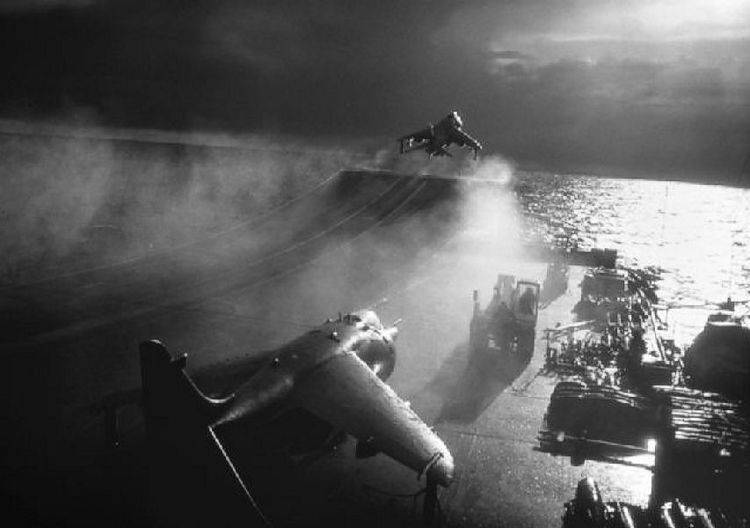
In total, from May 26 until the very end of the war, Argentina’s strike aircraft carried out 100 airplanes, while the ground positions and British ships were attacked 17 once, once again by “Pucara” attacked the air target (the British Scout helicopter was shot down). The Sea Harriers were able to thwart one attack of the Argentines, failing to shoot down a single enemy plane, in another case, the British VTOL aircraft arrived at the moment when 4 Skyhawk attacked the landing craft LCU F4. As a result, the boat was sunk along with a load of equipment for the 5-th infantry brigade, 6 people were killed, but three Skyhawks were shot down by VTOL aircraft. Thus, in the part of air defense support, the British carrier-based aircraft achieved impressive “success” - 2 interception for 18 attacks (11,1%), with only one attack from 18 repelled (5,55%).
Of course, the destruction of the Argentine airspace control system would have played an important role in providing British air defenses - in this case, the airplanes from the continental air bases lost target designation from the ground, but the Argentine radars were not too tough. As a result, the task of their destruction had to be entrusted to the "Volcanoes" of the Royal Air Force, as they were able to use Shrike anti-radar missiles. On June 1, the BlackBank 5 suffered a setback, but the 3 of June, during the BlackBack 6, the main radar of the Argentine air defense system was disabled.
The British aircraft did not succeed in destroying the light attack aircraft of the “Pukar” and the training “Ayrmachi”, because the bad weather and ground defense forces did it for them. For example, on the day when the British Scout was shot down from two Pukar, only one returned to the airfield, the second attack aircraft crashed, landing in a zone of low clouds. In the last operation of the light air forces of the Falkland Islands, undertaken by two Airmachi and two Pukar, one Airmachi was shot down from Bloupe Man-portable air defense systems, one attack aircraft was destroyed by anti-aircraft artillery fire, and the second received such damage that although he managed to return to the airfield, he could no longer fight.
The main runway of the Malvinas Islands (Port Stanley airfield) functioned until the end of the war; neither British deck aircraft, nor Volcanoes could do anything about this concrete road. The last time it was bombed on the night of June 12 (“Black Buck-7”), and in the evening of the same day, the last cargo Hercules arrived in Stanley. Surprisingly, the Argentine “air bridge” also functioned almost to the very end. The only C-130 that managed to destroy C Sea Harriers during the entire war (this happened on June 1) attempted to conduct intelligence activities.
And finally, ground operations. In essence, only one thing can be said about “Harriers”: “They were there”. Here, for example, what A. Zabolotny writes in the article “Harrier” is the Falklands bird of prey ”:
800-I squadron participated in the Falkland conflict from the very beginning, it dropped 63 bombs and tapes. Is it a lot or a little? For example, on May 29, during one, but massive, raid, British carrier-based aircraft dropped 27 time bombs on the Stanley airfield, which then exploded for four hours. The next day, the British “Harriers” four times (on 09.30; 10.30; 12.25 and 14.40) bombed the unfortunate airfield, and during these attacks dropped more 27 bombs - again, without much effect. Thus, from 1 on May to 14 in June, when the Argentine garrison capitulated 800-i AE dropped all on 9 bombs more than it was dumped on the Stanley airfield in two days of not too intensive work (29 in May - just one hit) . It is difficult to call it a great achievement.
It is also worth remembering that in total in the conflict zone there were aircraft of five air squadrons - 800-I, 801-I, 809-I, 899-I squadron of the Navy and 1-I squadron of the Air Force, the latter being equipped with “GR.3 Harriers”, which were not were able to conduct air combat and were used exclusively for ground attack. What, apparently, explains the relatively high consumption of aerial bombs - 150 pieces. Airplanes of the remaining squadrons are unlikely to have “thrown” bombs more than 800-AE. And it must be borne in mind that a significant part of the bombing was “pulled” by the airfields of Gus Green (Condor base) and Port Stanley (Malvinas Islands), which the British attacked as regularly as they were unsuccessful.
Of course, something fell to the land forces of Argentina, and this “something”, of course, added anxiety to the Argentines, but on the whole the “Harriers” did not play any significant role in ground battles. The most important factors determining the success of the British landing were:
1. Powerful and long-range artillery of the British ground forces, surpassing that of the Argentines.
2. Extensive use of the Milan “ATGM” to suppress Argentine gun emplacements.
3. Night vision devices, which gave the British an invaluable advantage in night battles, against Argentines not equipped with such means.
4. Artillery support ships.
5. Fortitude British infantry.
According to paragraph 5, I would like to note that during the battles for Gus Green, Darwin and Port Stanley, the British repeatedly engaged in hand-to-hand combat, and the number of Argentines killed or wounded with a bayonet is a noticeable magnitude. For example, as a result of the fighting for the height of Longdon (according to D. Tatarkov, “The conflict in the South Atlantic: The Falklands war of 1982”):
Perhaps the only notable achievement of the British VTOL for the support of the troops was the destruction of the Argentinean 28 air defense battery in May, which was located at the forefront of the Argentinean forces defending Goose Green. The guns were located just 180 meters from the British infantry, but three “Harriers” from “Hermes” were able to deliver a jewelry punch without hitting their own. By this time, the battle was already 36 hours and the parties were in a state of unstable equilibrium, and the destroyed battery was the basis of the firepower of the Argentines defending here. Its destruction tipped the scales on the side of the British, soon the Argentine commanders sent their parliamentarians to discuss the terms of the cease-fire. After the negotiations, which lasted all night, the Argentine troops, who defended Gus Green, capitulated.
In general, during this period, the combat activities of carrier-based aviation by the British are not impressive. However, during the period of May 26 - June 14, 5 Xi Harriers and GR.3 Harriers were lost.
27 in May, two “Harrier GR.3” from the aircraft carrier “Hermes” attacked the position of the 105-mm battery of the Argentines, covering Gus Green. Despite the target designation of the ground gunner (or maybe, on the contrary, “thanks” to him?), The target failed to hit either the first or the second approach. Well, on the third run, "Harrier" by Lieutenant Iyveson was so damaged by shells of 35-mm rigs that the pilot was forced to eject.
"Sea Harrier" died on the day of the already-mentioned bombing of the Stanley airfield on May 29. The Argentines claim that the plane was shot down by the Roland air defense system, while the British insist that the Harrier with the tail number ZA-174 fell from the flight deck of Invincible at the time of the turn and the accompanying roll.
30 in May “Harrier GR.3” in the height area Wall got hit by an 35-mm projectile, as a result of which it began to quickly lose fuel. Pilot D.Puk tried to bring the plane to the aircraft carrier, but he did not succeed - the plane fell into the sea in 30 miles from the escape deck.
1 June two “Sea Harrier” were caught in an Argentine ambush: anti-aircraft artillery fired at them near the coast, which forced the pilots to gain altitude and was immediately hit by Lt. Mortimer’s machine and was hit by a Roland missile system. The pilot spent several hours on a rescue raft a few kilometers from the coastline, but was rescued.
June 8 “Harrier GR.3” for technical reasons (officially: “loss of thrust from landing approach) fell near the airfield of San Carlos. Damage was such that the aircraft could not be restored.
Thus, it can be stated that in spite of a certain, and, in general, non-zero utility of VTOL aircraft, they could not cope with any task that the British aircraft faced in the Falkland conflict. On this one could finish the description of the battles and proceed to the conclusions, but still the story of the 1982 conflict of the year will be incomplete without mentioning the two attacks of Argentine aviation on British ships.
The destruction of the Atlantic Conveyor and the death of ten (or still eight?) Transport helicopters led to very far-reaching consequences — the British simply could not transfer enough forces to storming Port Stanley by air. Nobody wanted to send troops on foot march - in the absence of roads there would be a lot of problems. Therefore, the British conceived another landing operation, namely the transfer of the 5 brigade to the Port Fitzroy and Bluffkov area.
Of course, first it was necessary to make sure that there are no large forces of Argentines in the area of the future landing. This was done with a truly English humor - a helicopter threw the British reconnaissance group onto the lonely Swan Inlet House farm, not far from Port Fitzroy, after which the commander of a dozen diseased paratroopers ... called one of the residents of Port Fitzroy and asked him about the presence of Argentine troops.
Landings from the sea began on the night of 5 on June 6 and lasted for several days, but the Argentines discovered British ships in Port Fitzroy only on June 8. It must be said that in the absence of any serious opposition from the Argentines, the British unacceptably relaxed - in fact, their two amphibious vehicles were unloaded in the bay without direct protection of warships, having only C-Sea patrols deployed on the banks of the Rapier air defense system.
First of all, the Argentines sent 2 "Mirage" so that they distract the British air patrol. At this time, the 8 Skyhawks and the 6 Daggers should have been destroyed by British transports. But it turned out as always - the Mirages did not find anyone and flew off with nothing, and the six Daggers on the way to Port Fitzroy accidentally stumbled upon the Plymouth frigate. The commander of the Daggerov group decided that since the suddenness was lost, he would have no chance to break through to the landing craft and attacked the Plymouth, which received direct hits from four bombs. As usual, none of them exploded, but this was enough for a small frigate - Plymouth did not take part in the battles anymore. And besides, the Daggers performed the work of the Mirage, a pair of Sea Harriers patrolling over the landing site, rushed after them in pursuit. And at that time, five Skyhawks (out of eight, three returned for technical reasons) attacked Sir Tristram and Sir Galahad. "Sir Tristram" received two bombs, one exploded, the ship lost two people, but was completely incapacitated and no longer participated in combat operations, like the Plymouth. But "Sir Hallahed" got 3 bombs, all three exploded, and one - in the landing room, filled with Welsh Guardsmen, and then detonated on board the prepared ammunition. The ship was completely burned out, but somehow miraculously kept afloat, its body was subsequently submerged in close proximity to the coast. The British recognize the loss of 50 people and 57 more seriously injured.
The Argentines raised six more Skyhocks, two of which returned to the airfield, and four flew to Port Fitzroy, but then they were met by the “awakened” air defense bridgehead. Understanding that they would not pass, Skyhawks lay down the opposite course, accidentally found the amphibious assault boat LCU F4 in the Gulf of Choiseul, attacked him and sank, but at the time of the attack they themselves were covered by C Harriers, who shot down three Skyhawks from four.
The latest attack on the British carrier carrier, undertaken by 2 Super EHTANDAR and 4 SkyHawk, has been described in many sources, but its effectiveness remains a mystery to this day. This time, the “Agavam” “Superov” managed to detect a large ship on the 25 miles, after which the last “Exochet” was immediately launched, and the 4 “Skyhawk” followed her at an altitude of just 12 meters. The British did not sleep, there were three ships between the attacking aircraft and the Invincible aircraft carrier - the destroyers 42 Exeter and Cardiff and the frigate 21 Eweger. They spotted the Argentinean aircraft before the launch of the "Exochet" and knew what they would encounter. It is reliably known that two Skyhawks were shot down by the Sea Dart air defense system of the latest modification installed on the Exeter, while the other two were able to attack the British. For the rest - continuous discrepancies.
Argentines claim that they saw "Invincible" shrouded in smoke (from the RCC hit it), and the two Skyhocks achieved three hits of 250 kg by bombs. The British claim that the rocket did not hit anywhere, and the Skyhawks attacked the frigate Avenger, shrouded in smoke from firing its gun mounts. Who is right?
On the one hand, the British should know better about their losses. But there are some very strange facts that are difficult to ignore: according to the Argentine radio-electronic intelligence, immediately after the attack on Invincible, the British helicopters had an excessive activity. At the same time, a group of Sea Harriers at high altitude carried out a flight to a temporary airfield in San Carlos. On the same day, the command post of General Moore was transferred from Invincible to San Carlos, and an analysis of British flight activity after the 30 in May revealed a significant decrease in the next few days. But the most important thing is the discrepancies in the reports of the British themselves. 1 June, the British Defense Ministry announced that 30 was attacked not by Invincible, but ... the still-sinking Atlantic Conveyor. But 3 June version has changed: the British declared an unsuccessful attack of "Evenger".
What really happened? Alas, most likely, we will never know.
The ending should ...
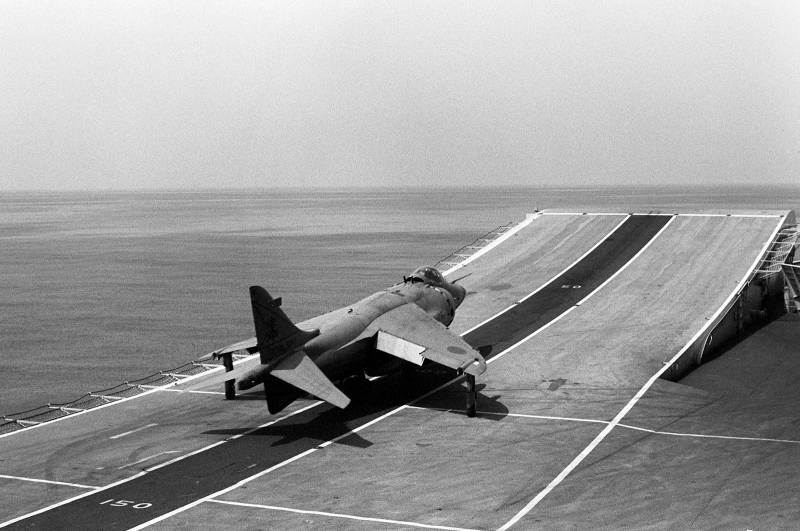
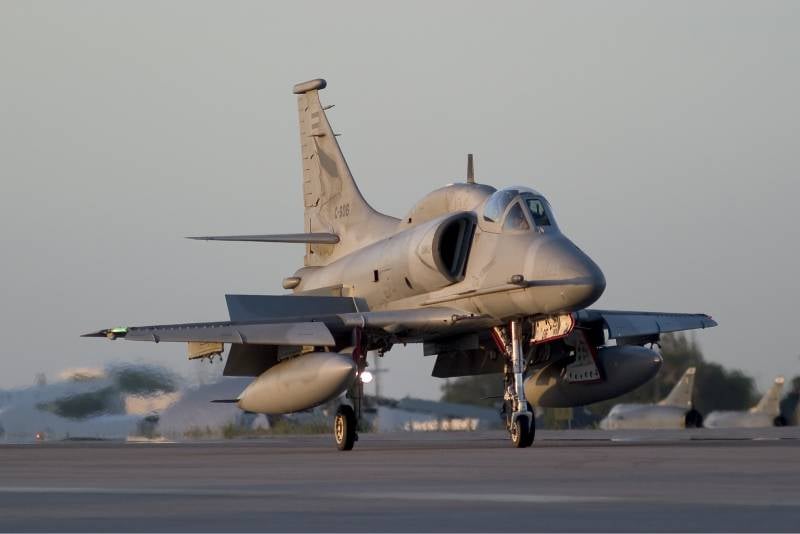
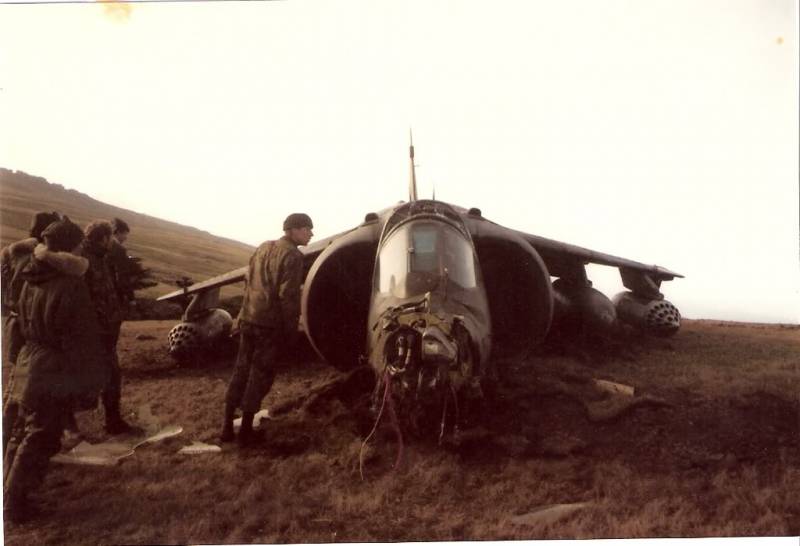
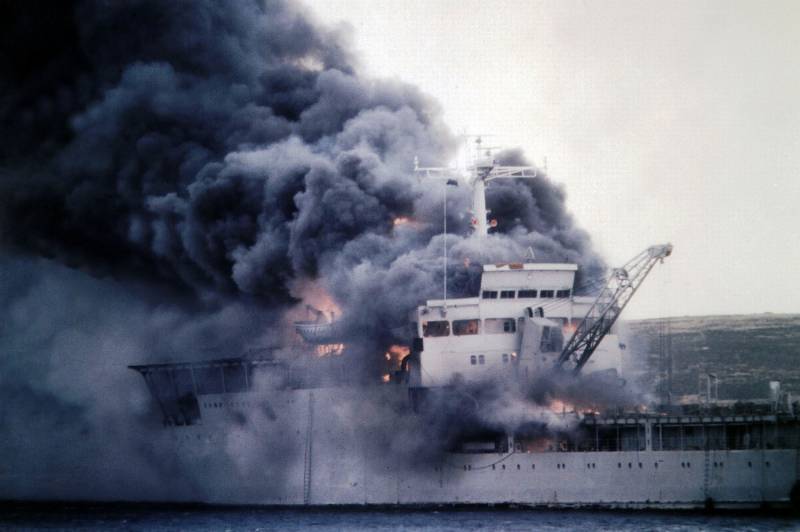
Information